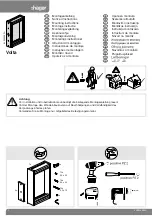
7
Instruction Booklet
IB02201004E
Effective October 2017
Revision #4
Instructions for installation, operation, and
maintenance of 38 kV type VacClad-W,
150 BIL switchgear indoor housings
EATON
www.eaton.com
Step 2: Check the entire lineup to make sure it is level and plumb
prior to bolting or welding the base members of the vertical
section frame, front, and rear to the foundation .
Step 3: Remove all shipping blocks or braces and lifting angles .
A . Examine all meters, relays, and so on, and remove any shipping
blocks or braces .
B . Remove the lifting angles from top of the units and discard them .
C . Additional bracing is provided in the auxiliary module to secure
the transformer drawers during shipment . The bracing is painted
yellow . Remove this bracing .
Step 4: Connect the ground bus .
A . Ground bus is located in the rear of the equipment . The stan-
dard ground bus is a 0 .25 × 2 .00 in . (6 .4 × 50 .8 mm) copper
busbar bolted to the cross members of the frame in the bottom
of each switchgear unit . The ground bus runs through the center
of each unit, through the length of the entire switchgear assem-
bly . Install the ground links and hardware (located in detail box)
to connect the ground bus at the shipping sections (see Figure
2) . Torque the hardware per the specifications contained in
Table 3 .
Figure 2. Ground Bus Installation.
B . Connect the switchgear assembly to the station ground .
Solderless terminals are provided on the ground bus at each
end of the switchgear for this purpose . The connection shall
be made as direct as possible . The connection shall be large
enough to carry the ground fault current of the installation .
Never encase the ground bus in a metal conduit .
CAUTION
THE SWITCHGEAR INSTALLATION MUST BE PROPERLY GROUNDED.
otee:
N
For the design and installation of a grounding system, refer to Electrical
Power Distribution For Industrial Plants (Institute of Electrical and Electronics
Engineers [IEEE
®
] Std 141); Grounding of Industrial and Commercial Power
Systems (IEEE Std 142); and the NEC, Articles 100, 200, and 250 .
For generating stations and larger substations, the ground resistance
should be 1 ohm or less . For industrial plants and small substations,
the ground should be less than 5 ohms (the NEC states that the
ground resistance should never exceed 25 ohms) .
Ground Link
Step 5: Connect the high voltage bus between the shipping sections .
A . Remove the rear covers or open the rear doors (if applicable)
of any remaining cells that were not opened during prior steps .
Remove from these sections the angled metal barrier and verti-
cal main bus barrier from the cable compartment in the rear
of the switchgear (see Figure 3) . Also remove any other com-
ponents such as potheads, surge suppressors, and so on, that
interfere with access to these barriers .
otee:
N
The rear assembly of switchgear may vary .
B . Obtain the section of bus that was removed to separate the
groups for shipping . Each section is labeled and shipped in the
carton with the detail box .
C . The surfaces in the bus joints are plated . Clean the plated sur-
faces of the bus section with isopropyl alcohol if necessary .
otee:
N
Plating may show signs of tarnish over time . This does not affect the
functionality .
D . Slide the section of main bus through the supports in the side of
the vertical section . Slide the rubber snubber along the bus until
it fits inside the opening in the bus support .
When the bus section is disconnected for shipping, the splice
plates and hardware are left bolted to the end of the bus in each
of the adjoining vertical sections . Sandwich the end of the dis-
connected section between the splice plates and fit the other
end of the section between the splice plates on the end of the
bus in the adjacent section . Bolt the splice plates together on
each end of the bus section (see Figure 4) . Do not tighten until
all joints throughout the line-up are installed .
E . Repeat these steps for each section of bus at each shipping
break .
F . Torque the bolts in the splice plate to the values shown in
Table 3 . Make sure all structure and tie bolts are torqued prior to
torquing bus-joint bolts .
G . Insulate each bus joint with plastic joint covers or insulating tape
for unusual configurations (see Figure 5) .
Figure 3. Main Bus Installation – Bus Barriers Shown.
Angled and
Vertical Main
Bus Barriers








































